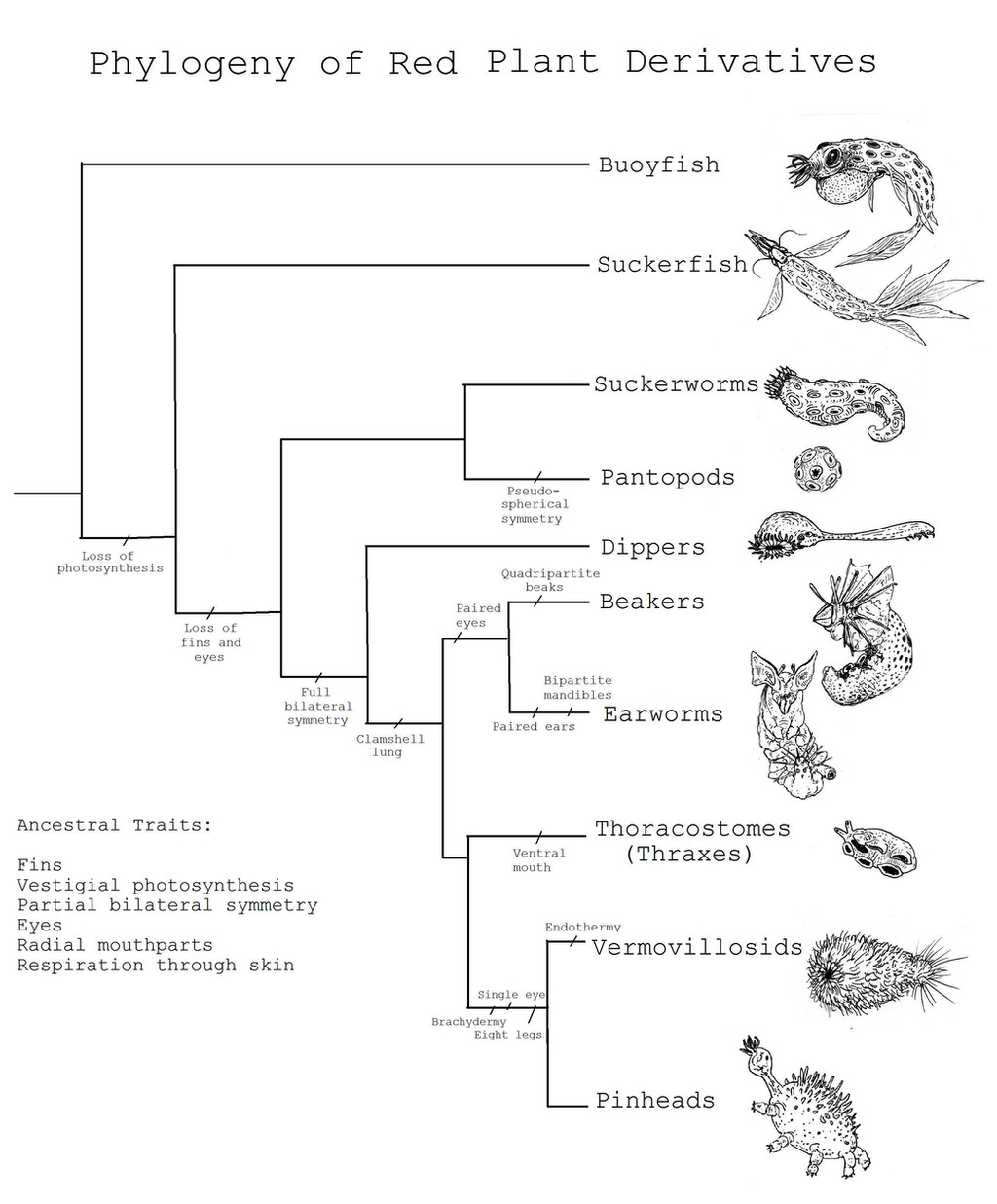HOME | DD
 Malicious-Monkey — Phylogeny of Red Plant Derivatives
Malicious-Monkey — Phylogeny of Red Plant Derivatives

Published: 2013-08-30 04:42:53 +0000 UTC; Views: 2585; Favourites: 33; Downloads: 13
Redirect to original
Description
This is the REVISED phylogeny of red plant derivatives. The old one is ugly and out of date and no good, so it's going into scraps. With this, all animals and plants of Ilion are covered. Now I can zoom in on individual groups as I please, or move on to microbes and pseudofungus.Red Plant Derivatives
Since red plants are essentially animals that horizontally acquired the ability to photosynthesize from algae, their reproductive form retains many animal-like traits, including the ability to move and eat. It should come as no surprise, then, that another type of animal might emerge from this group. As a need arose to for one red plant to disperse across oceans, its swimming larva evolved to hunt, respire, and produce copies of itself if necessary. This lineage gave rise to most of the megafauna on land and in sea. Most red plant derivatives are not photosynthetic. Instead, the pigments have been repurposed to carry oxygen in the bloodstream, giving the animals their characteristic pink hue.
Buoyfish – As the name suggests, buoyfish are the closest relatives to the tropical buoyphyte that spawned the first independent larva. Although they don’t look much different from other aquatic red plant derivatives, buoyfish are the only remaining group that retained its photosynthetic plant form, which it carries in a throat pouch. In all other groups, its only function is reproduction.
Suckerfish - In the past, suckerfish were an evolutionary grade, but only one clade remains today. They dominate many waterways as low-level predators and plankton eaters. They are the last to possess their ancestral fins and eyes, as all others found the sensory mouthparts more useful than the rudimentary eyes possessed by some mobile fruits. The suction pads filled the role of locomotion in pantopods and enantiopods (see below).
Pantopods – Although they appear spherically symmetrical, they are nothing more than vertically compressed suckerworms. They are notable for thriving on both land and in water, using their spiracles as suction feet for rolling locomotion and food acquisition.
Dippers – Also known as spoonworms, dippers are the most basal of the bilaterally symmetrical enantiopods, which are characterized by two opposite rows of suction pad feet. However, having adapted to a parasitic lifestyle, they hardly resemble their ancestor at all.
Beakers – Several of the animal’s mouthparts were repurposed as sensory organs and neck frills. The remaining four have hardened into a beak. Some beakers can produce a glue-like substance from glands in their chin which they use to trap prey and build protective structures for themselves and their young.
Earworms – The sensory organs are more specialized in earworms than in beakers. The front pair have flattened into ears, while the back pair are eyes. The eyes are often stalked so they can see above and around the ears, which can be quite prominent in some species. Some earworms can produce a glue-like substance from glands in their chin which they use to trap prey and build protective structures for themselves and their young.
Thoracostomes - Also called thraxes, these animals are simply everywhere. Their simple design opens up a wide variety of niches and body forms. Even in the tundra, where their ectothermy seems ill-suited, thraxes make a home out of the backs of the resident megafauna.
Vermovillosids – The hairy grubs and their descendants are a broad group of furred, warm-blooded animals. The grubs are an essential part of the soil community in most land ecosystems, while their descendants make up the majority of Ilion’s megafauna.
Pinheads - Pinheads are the vermovillosids’ diminutive sister clade. These unassuming soil organisms are present all over Ilion’s habitable half. Few reach sizes larger than what can fit on the head of a pin. There are four orders which are known only by their greco-latin name, as are most species within the group. They help dead organisms decompose and are a food source for many small animals.
Zoom out: Red plants
Zoom in: Earworms
Zoom in: Beakers
Zoom in: Vermovillosids
Zoom in: Thoracostomes
Zoom in: Pinheads
Related content
Comments: 4

can you design the alien animals for a planet of mine?
👍: 0 ⏩: 1

awesome cladogram! you have one of the best alien planet projects i've seen so far!
👍: 0 ⏩: 0

























